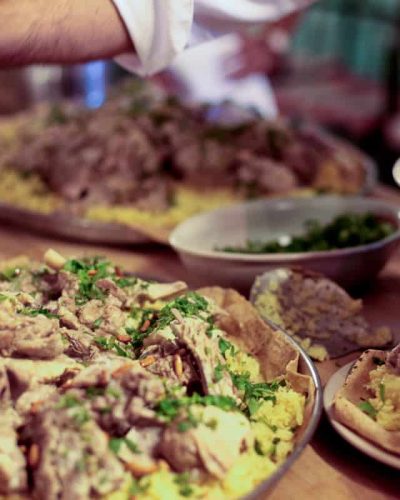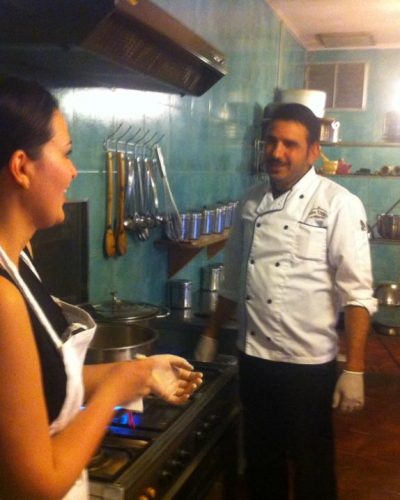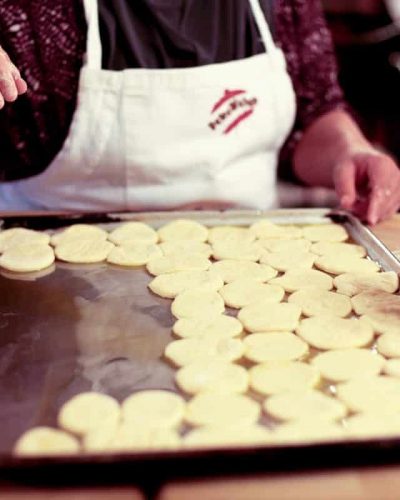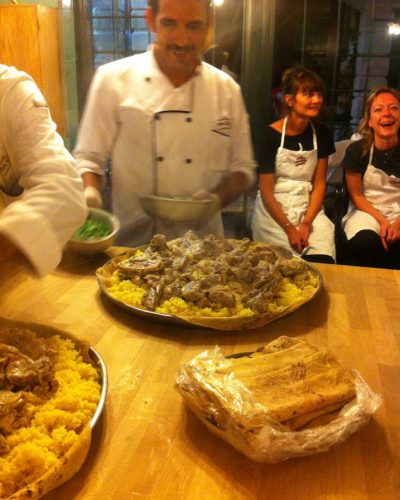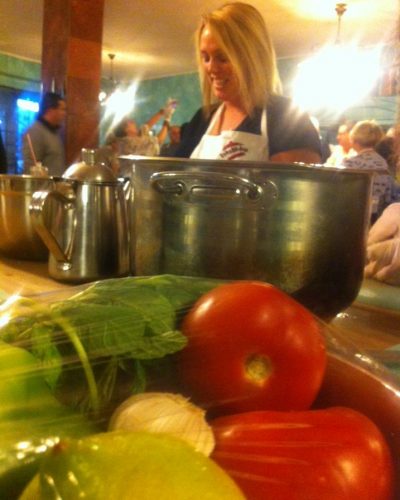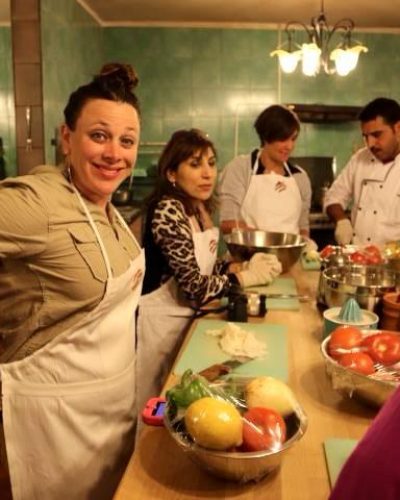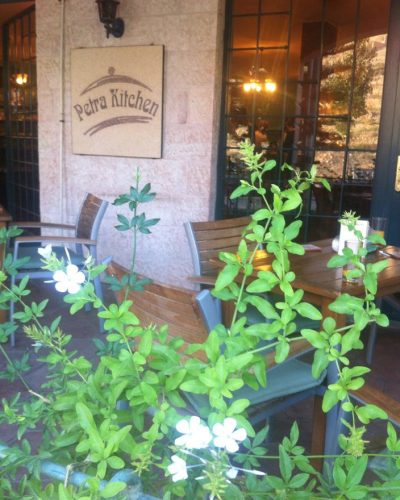Blog
Ramblings, Recipes
& More
Galayat Bandura
January 23, 2018
Galayat bandura is a popular dish which can be found served for breakfast, lunch or dinner, as hot mezza or main course. “Galayat” is the Arabic word for “skillet,” so the name literally translated would be “skillet of tomatoes.”
1 lb ( ½ kg) tomatoes | 4 garlic cloves |
¼ C. olive oil | ¼ C. pine nuts |
2 green chili peppers | 1 t. salt |

Saute the pine nuts in oil until light brown. Remove from oil and reserve as garnish.
Chop tomatoes and chilies finely.
Slice garlic and sauté in the same oil until light brown. Add tomatoes, chilies and salt.
Bring to a boil. Boil for 5 minutes, stirring constantly.
Reduce heat and simmer 15 minutes.
Pour into shallow serving dish and garnish with pine nuts.
Baba Ghanouj
December, 2017
One of the best parts about Middle Eastern food is that you can fill up (and then some) on “appetizers” alone. Mezze-style eating is one of my favorite things, both because of the variety of dishes and because of the communal style of eating. To me there is nothing better than sharing plates and plates of appetizers among friends. It gives ample opportunity to serve and be served by others as people pass plates around or take turns dipping into a bowl. Anyone who has read other blogs by me knows that the foundations my life are built upon bread. As such, I really enjoy mezze I can dip into.
While hummus might be more famous, I really enjoy dipping into a nice bowl of Baba Ghanouj. Baba Ghanouj is made from mixing mashed roasted eggplants with tahini paste and roasted garlic. It is served cold with pita, but there are many variations to try from. I’ve had some that has some added sugar for a little sweetness, and even tried some with roasted peppers. There are many different varieties and like most dishes people have their own way of preparing them. There is no better eating than with my friend Rania’s family, so I asked her to let me in on her recipe so I can share it with you! While it is not strictly necessary, having a food processor makes this job a lot easier. According to Rania, the most important aspect of preparing Baba Ghanouj is getting the right balance of flavors. This is a dish that you have to keep tasting regularly as you prepare and adjust accordingly. While I enjoy this recipe as is, it can be augmented to fit any palate. Here’s what you will need to get started:
-2 medium Aubergines (eggplant)
-1/3 cup of light tahini paste
-2 juiced lemons
-3 cloves of garlic (hope you love garlic)
-1/2 tsp. salt
-1/2 tsp. cumin
-Extra virgin olive oil
Optional
-a pinch of red pepper
-a sprinkle of paprika (smoked or otherwise)
To begin with, you will need to roast both the aubergines and garlic. This is a very important step to get the proper base flavors. Remember to remove the skin from the roasted eggplant before starting the recipe!
To roast the aubergines, preheat the oven to 240C and wash and cut aubergines in half lengthways. Place skin side down on baking tray. Bake about 30 minutes. Remove from oven and scoop aubergine out of the skin. Optionally you can roast the aubergines over an open flame for a smokier Baba Ghanouj.
To roast the garlic, remove the outer layer of the bulb and then cut ¼’’ off the top of the bulb. I suggest making little aluminum foil squares to put the bulbs in. Once the bulbs are placed in the squares, drizzle 2 tsps of olive oil on each bulb. Place in oven and roast for 30-35 minutes or until garlic cloves soften. When properly roasted, cloves should come out of their shells with a spoon easily.
Mix the roasted eggplant and garlic together with the tahini paste, lemon juice, salt, cumin, and 1 tbsp. of the olive oil. Using a fork, mash together the mixture in order to break up all the garlic, eggplant, and tahini. This can also be done using a food processor.
Taste and adjust flavorings accordingly. When ready to serve, drizzle with a little bit of olive oil.
If you roast the aubergines over an open flame, my suggestion would be to use regular paprika rather than smoked paprika, because Baba Ghanouj can become very smoky, very quickly. While it is an interesting taste, I prefer my Baba Ghanouj to be on the less smoky side.
Serve with fresh pita bread for an authentic taste, but between you and me you can use this like any other dip, eating it with any number of breads, crackers, and chips. Another suggestion is if you are going to be eating with a large number of people double recipe and make both smoky and regular Baba Ghanouj so everyone can enjoy the varied flavors. If you want to serve it chilled, place the Baba Ghanouj in a covered bowl in the refrigerator until ready to serve.
Kofta Bil Tahini
November, 2017
There are myriad reasons to visit the Middle East, but one thing that sticks with travelers long after they have left the region is a love of Middle Eastern food. Each country had their own dishes, or variants of the same dishes, in addition to sharing much with Mediterranean cuisine. While the region has become famous for its mezze (very similar to tapas), there are also many gastric delights to be had with the heavier regional fare. One of my favorite dishes to eat myself into a food coma with is Kofta bil Tahini, or Kofta with Tahini sauce. This succulent dish has become the Fish & Chips of the Arab World for me: if it’s on the menu, I have to order it. As such, I’ve had the pleasure of trying many variations of the dish around Jordan. The basic premise though boils down to 3 main aspects: The kofta, the potatoes, and the tahini sauce.
The kofta is a mouthwatering blend of ground meat (normally lamb or beef) mixed with herbs and spices. In the dish, you’ll often find it shaped like kebabs, meatballs, or patties. Layered on top of the meat are fried or boiled potatoes. These are normally sliced, either thin or thick, but I’ve also enjoyed a few restaurants that have cubed them or even used whole baby potatoes. Surrounding the meat and potatoes is a delicious tahini sauce. Most variations of the sauce are thicker, especially considering tahini tends to thicken over time, but I have had some thinner sauces that have worked well. Often served in the clay pot or metal tray it was cooked in, this hearty fare will win you over before the first bite. While great on its own, the dish reaches new heights when paired with fresh baked khobz (similar to pita, not to be confused with the Moroccan bread of the same name) or rice. OK, do you remember back then when I said bread or rice? If we are being honest with each other I have, on occasion, had it with bread and rice. Don’t act like I’m the only one who ever turns into a carb fiend from time to time. If I am forced to make a choice between the two, I lean towards the bread pairing. This could be because I have, since I was a little kid, been on a quest to turn every meal into a sandwich. Don’t ask me why; it’s just one of those things. The most important thing is that regardless of what variation you get, be prepared for a culinary masterpiece.
I enjoy this dish so much that I have even tried my hand a few times at making it at home, and not just because I can hide my carb shame and slip into my kofta coma with some Netflix. Luckily my good (and non-judgmental) friend Rania is an amazing cook and was kind enough to share her recipe for Kofta bil Tahini with me. Before the mob comes for me, let me say that this is not a secret family recipe, and I have full permission to share it with you! So put down you pitchforks and pick up your forks, because here is the full recipe:
What you will need for a 4 person batch:
Kofta
-500 grams ground beef/lamb (lean)
-1 large yellow onion chopped finely
-1 clove of garlic minced
-75 grams parsley chopped finely
-Salt and Pepper
-half teaspoon allspice
500 grams peeled, washed, then sliced potatoes 1-2 cm thick
Tahini Sauce
-1 cup tahini paste
-Juice from 1 lemon
-1/2 teaspoon salt
-1 cup yogurt
-3 cups boiled water
Non-stick round tray (21 cm in diameter, 5 cm deep)
Directions
1. In a mixing bowl, combine meat and spices and mix by hand. Next, add onion and parsley and again mix by hand. You can add the mixture to a food processor and give it a couple whirls if you aren’t satisfied by the texture, but that just means more cleanup. Move the mixture to a dish and cover and put in the fridge until cooking time.
2. Preheat oven to 190C (375F).
3. Boil the potatoes for 3 minutes, then drain immediately and set aside.
4. Coat base of tray with desired oil.
5. Spread kofta mixture 2-3cm thick and make a hole in the center.
6. Spread the potatoes over the mixture and season with salt and pepper. Cover the tray in foil and cook for 40 minutes.
7. Mix tahini, lemon, salt, yogurt, and 1 cup of water together. As mixture starts to thicken pour remaining water slowly into the mixture.
8. After 40 minutes take tray out of oven and remove foil. Bake for another 10 minutes. Remove tray again and then cover kofta with tahini sauce. Bake for another 5 minutes.
9. Remove from oven and serve immediately.
10. Optional- use khobz or pita to scoop up as a sandwich!
